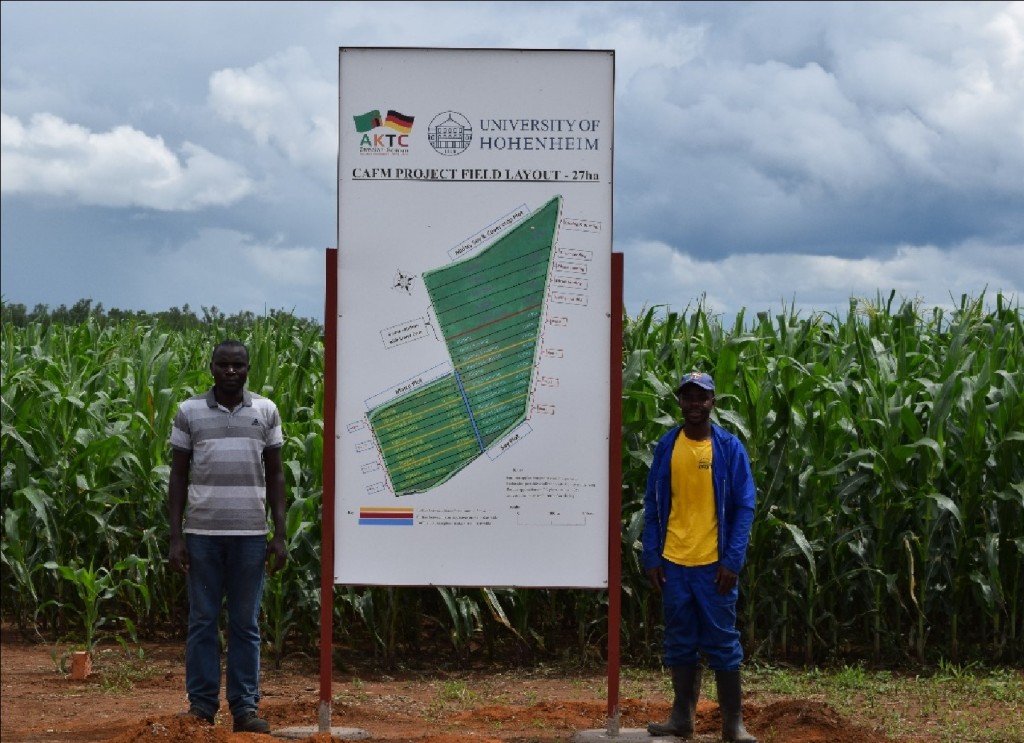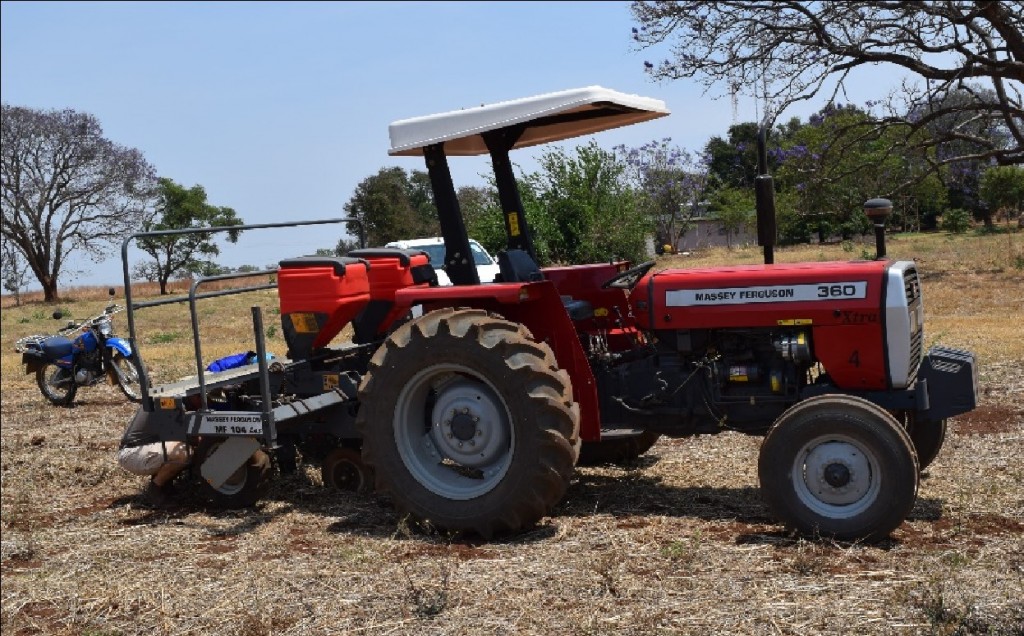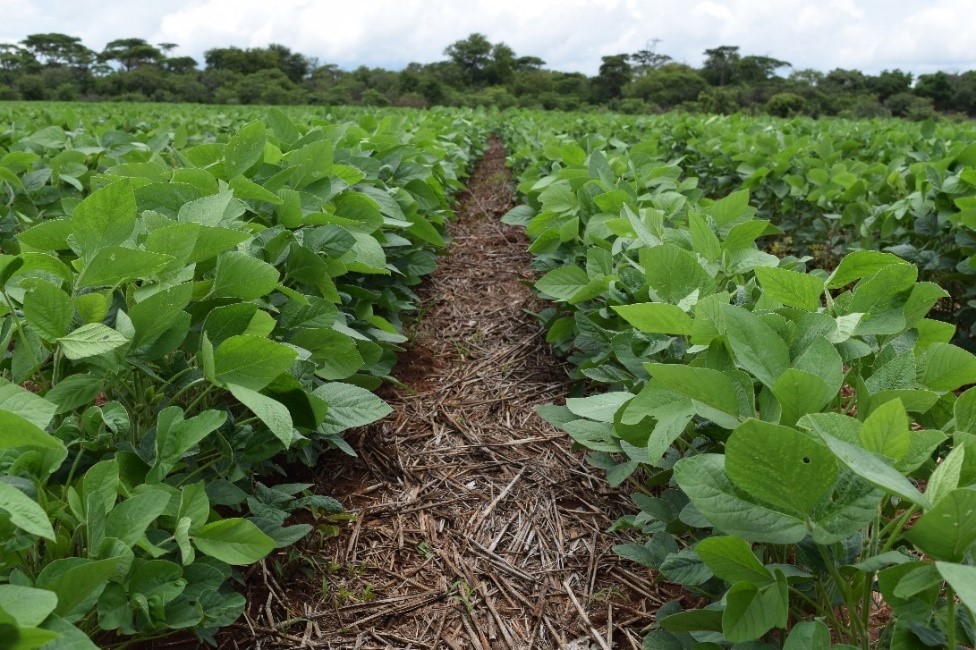Climate Adapted Farming Methods in Zambia:
Improving CA performance through appropriate mechanization
Are small-scale and emergent farmers able to practise mechanized conservation agriculture in Zambia? The mechanized conservation agriculture (MCA) on-farm experiment at the Zambian-German Agricultural Knowledge and Training Centre, situated at the Golden Valley Agricultural Research Trust (GART) is the surest answer.
Everybody in Zambia concurs with the reality of climate change since the impacts are visible across the entire nation. Small and medium-scale farmers who entirely rely on rainfed agriculture for both crops and animals’ production are the most affected. In the recent past, the unpredicted rainfall patterns have resulted in late planting leading to yield losses due to drought that follows. The rains come as late as December-January and end too early in the season, but often they cause floods since they are erratic. This phenomenon is not only a scene in Zambia but also across entire sub-Saharan Africa (SSA) and the world over.
These challenges facing the Zambian farmers call for viable and sustainable solutions. The solutions should be not only feasible but also sustainable while mitigating the impacts and adapting to the effects of climate change. Like other developing countries, Zambia is faced with the reality of poverty and food insecurity due to unsustainable agriculture. Thus, through climate-adapted farming approaches, the agricultural sector can secure farmers from climate related losses.
The climate adapted farming methods project (CAFM), an initiative of the Zambian-German Agricultural Knowledge and Training Centre (AKTC), could not be timelier and more relevant. AKTC is a bilateral cooperation between the German Federal Ministry of Food and Agriculture and the Zambian Ministry of Agriculture.

Figure 1: Sign board showing MCA experimental field layout. Left: Godfrey Omulo, PhD candidate from University of Hohenheim, Right: Abraham Kapela research assistant. Photo courtesy of Innocent Maphango.
Ministry of Agriculture. It is located at the Golden Valley Agricultural Research Trust (GART) in Chisamba. The CAFM project, which started in 2019, is aimed at minimizing climate-related yield losses and securing income among small-scale and emergent farmers through the practice of MCA.
Even though conservation agriculture (CA) is widely known and appreciated in Zambia, its practice and adoption are still very insignificant. This is at the backdrop of its immense potential to spur agricultural productivity in Zambia. CA practice has been adopted mainly by small-scale farmers though they are facing drudgery and mechanization challenges. The farmers use hand hoes for making planting basins while others use animal-drawn implements. The manual digging of holes is too labour intensive and time-consuming. This has made CA practice unappealing to emergent and large-scale farmers who operate on large pieces of land.
The benefits of CA among small-scale farmers compared with conventional counterparts under the same climatic conditions cannot be overemphasized. The benefits include improved soil structure, water infiltration, soil microbial activity, time and labour reduction and yield. Thus, to effectively tap on these potentials, barriers facing small and medium-scale farmers must be dismantled. The greatest barrier to CA adoption and up-scaling in Zambia being the lack of appropriate mechanization for land preparation, planting and weed control.
Even though some emergent and large-scale farmers have acquired tractors, they are not necessarily practising MCA. What could be the reason? Are MCA implements like ripper and no-till planters available in the Zambian market? Can the standard small four-wheel tractors achieve the desired CA operations?
Indeed tractors, rippers and no-till planters are available in the Zambian market. However, few on-farm research or experiment based on MCA are available for farmers’ demonstration and learning. Thus, the CAFM on-farm experiment on a 27 ha of rain-fed farming, was set to access the performance of MCA versus conventional farming with maize and soybean crops, and to analyze whether they are economically viable.

Figure 2: Modified MF100 planter mounted on 60 hp 2-wheel tractor
Experimental Description
To effectively access the effects of MCA and conventional farming on maize and soybean performance, three tillage practices were employed: discing (conventional), ripping and direct planting (conservation). The residues on the conventional plots were first burnt before discing; this was following the common practice of burning of residues every season among conventional farmers. With the 60 hp tractor, land preparation (disc harrowing and ripping), planting (including no-till), fertilizer application and weed control was done in time.
All agronomic requirements for the two crops were done correctly while crop development was monitored and observations throughout the season. Key components like operation time, fuel consumption, labour charges, rainfall amounts and soil moisture readings also were noted throughout the operations. Being the first trial, the maize-soybean rotation will be done in the subsequent 2020-2021 season.
The GART weather station has recorded a total 692.8mm of rainfall this season. However, compared to other regions of the country, the rainfall amount is quite low even though it is more than last season. With this constrained rainfall, interesting observations were made throughout the crop’s development under the various tillage types.
In general, good plant population was observed on the three tillage types. However, uneven germination was noted on disced plots, effects of which translated to the growth of crops throughout the season. Seeds planted on the disced plots were deprived of moisture due to the excessive evaporation during the dry spell, which resulted in hardpan. The residue cover on the CA plots cushioned the crops from birds and ants attack. The crops on the CA plots received least water stress during a two-week dry spell in December. Because of better water infiltration, soil moisture contents were highest in no-till plots and least in disced plots. Soil temperature and evaporation were higher in disced plots than in the ripped and no-till plots.
The time taken in land preparation and planting were double in the disced and ripped plots compared to no-till plots. Less amount of fuel was used on the no-till plots compared to the disced and ripped plots. Similarly, labour costs were highest in disced plots compared to ripped and no-till plots. Weed control, top-dressing and insect control operations recorded insignificant time, labour and fuel differences. Yield measurements per crop will be computed at the end of the season. However, physical inspections reveal taller crops with bigger cobs in MCA plots compared to disced plots.

Figure 3: Maize in No-Till plots at 14 weeks.
These preliminary results indicate that MCA is not only a climate-smart way of farming but also time-saving and more economically sound. The reduced fuel consumption and low labour costs can be used to more farm inputs while the time saved turned to other economically viable activities.
Farmers from the neighbouring districts of Chisamba and Chibombo got hands-on experience on MCA land preparation, planting and weed control at AKTC during the on-farm demonstrations throughout the season. This culminated by a successful field day on the 25th February 2020 which attended by close 200 farmers stakeholders. During this field day, the crop’s development under different tillage types was showcased. The farmers, partners and the stakeholders present appreciated the immense role mechanization can play in boosting CA performance. Among the institutions and stakeholders present were: GART, Conservation Farming Unit (CFU), BAYER AG, BHBW, Omnia fertilizers, Precision Farming, Seed Co,
University of Zambia (UNZA) and the University of Hohenheim in Germany. The National Agricultural Information Services (NAIS) enlightened the nation of the CAFM field day events on the National Broadcasting Cooperation (ZNBC) TV2 news on 26th February 2020.

Figure 4: Soybean on a No-Till plot after 8 weeks
The outcomes of the CAFM project are sure demonstrations that MCA has the potential to upscale CA adoption and overall agricultural productivity in Zambia. Through MCA, agriculture can become more profitable while offering farmers an opportunity to cope with the effects of climate change. This is true because, farmers are able conserved moisture, use less time in their farming activities and minimize cost on fuel. Through MCA, farming as a business is only economically viable but also sustainable since the conservation of soil and water translates to better soil quality and improved yields. To achieve this desired goal, CA must be mechanized and both the government and the private sectors have a big role to play.
Author
Godfrey Omulo
CAFM project lead researcher at AKTC and a PhD Candidate at the University of Hohenheim, Germany.
Contact:
AKTC
P.O.Box 108,
Fringilla Luaka – Zambia
helmut.anschuetz@afci.de


Leave A Comment